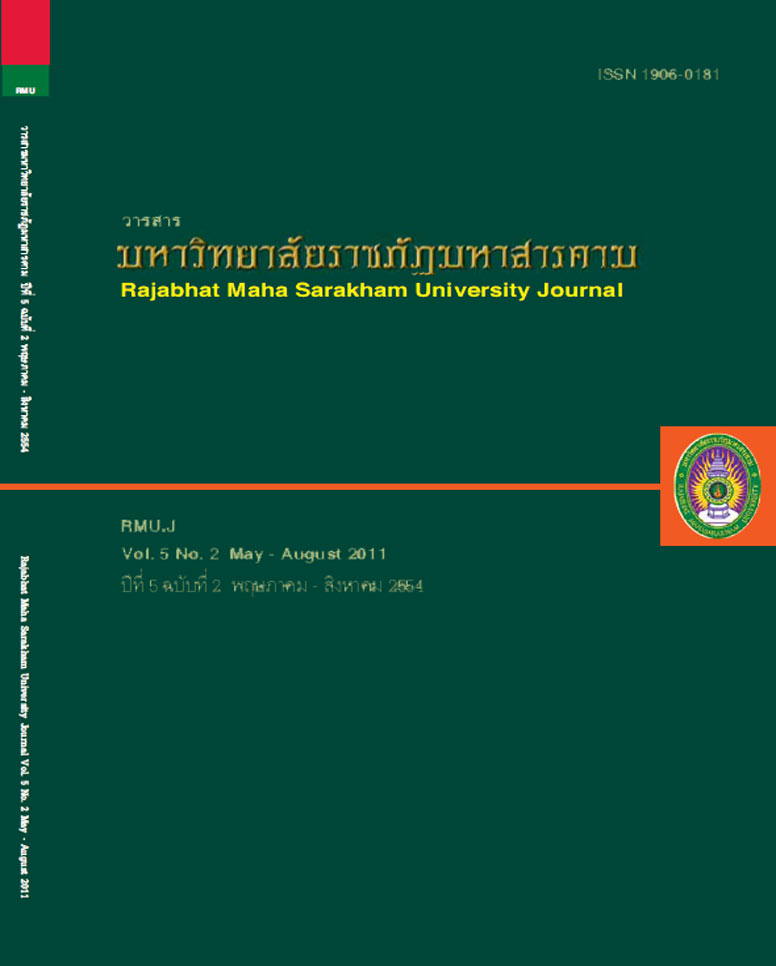รูปแบบการจัดตั้งและการคงอยู่ของระบบเงินตราชุมชน : ศึกษารายกรณีบุญกุดชุม; An Establishment and Maintenance Model of Community Currency System : a Case Study of Bun Kut Chum District
Main Article Content
บทคัดย่อ
การวิจัยนี้มีวัตถุประสงค์เพื่อ ประการแรก เพื่อศึกษาสภาพปัญหาด้านเศรษฐกิจของชุมชนในหมู่บ้านสันติสุข ตำบลนาโส่
อำเภอกุดชุม จังหวัดยโสธร ประการที่สอง เพื่อสังเคราะห์รูปแบบการก่อตั้งและคงอยู่ของระบบเงินตราชุมชน : บุญกุดชุม เพื่อ
ใช้แก้ปัญหาของชุมชน ซึ่งเป็นการวิจัยเชิงคุณภาพ โดยใช้การจัดประชุมกลุ่มย่อย (Socus group) และการสัมภาษณ์เชิงลึก
(In-depth interview) กลุ่มตัวอย่างเป็นสมาชิกที่ใช้เบี้ยกุดชุมที่อาศัยอยู่ในชุมชน ตำบลนาโส่ อำเภอกุดชุม จังหวัดยโสธร
จำนวน 289 คน โดยการสุ่มอย่างง่าย (Simple random sampling) ผลการวิจัยพบว่า
1. รูปแบบการก่อตั้งระบบเงินตราชุมชน : บุญกุดชุม เกิดจากปัจจัย 2 ประการ คือ สภาพปัญหาที่เกิดจากบริบทชุมชน
ชาวตำบลนาโส่ที่เป็นชุมชนเกษตรกรรมที่ตอบสนองระบบทุนนิยมทำให้เกิดปัญหาในการดำเนินชีวิต เช่น ปัญหาความยากจน
ปัญหาหนี้สิน ปัญหาความแห้งแล้ง ปัญหาการเอาเปรียบของพ่อค้าคนกลาง ปัญหายาเสพติด ปัญหาสิ่งแวดล้อม และปัญหา
ความขัดแย้งในชุมชน และปัจจัยเกื้อหนุน เช่น ความเข้มแข็งของชุมชน ความสามัคคีของชาวบ้านในชุมชน การมีผู้นำที่เข้มแข็ง
มีวิสัยทัศน์ การเปิดกว้างรับนวัตกรรม การรวมกลุ่มกันของชาวบ้าน การสนับสนุนขององค์กรเอกชนและรัฐบาลและการสื่อสาร
ของอาสาสมัครต่างชาติ
2. ปัจจัยที่เอื้อต่อการคงอยู่ของระบบเงินตราชุมชน : บุญกุดชุม ได้แก่ 2 ปัจจัย คือ ปัจจัยภายนอกซึ่งประกอบด้วย
การสนับสนุนขององค์กรเอกชน การสื่อสารจากสังคมทำให้ได้รับความสนใจ นักวิชาการจากนอกชุมชนให้การสนับสนุนและ
หน่วยงานของรัฐใช้เป็นแหล่งเรียนรู้และปัจจัยภายใน ซึ่งได้แก่ ประโยชน์ส่วนบุคคล ความสามัคคีในชุมชน ความเข้มแข็งของ
ผู้นำ การรวมกลุ่มเครือข่ายและสภาพสังคมในชุมชนที่เป็นสังคมชนบททำให้มีความใกล้ชิดกัน นอกจากนี้การที่ชาวชุมชนตำบล
นาโส่นำระบบเงินตราชุมชน : บุญกุดชุม มาใช้ทำให้เกิดกิจกรรมทางเศรษฐกิจและสังคมอื่นๆ เช่น การรวมกลุ่มเครือข่าย
เกษตรอินทรีย์ ชมรมหมอยาพื้นบ้าน โรงสีปลอดสารพิษและชมรมรักษ์ธรรมชาติ ซึ่งทำให้ชาวชุมชนหมู่บ้านสันติสุขมีความ
เป็นอยู่ดีขึ้น สามารถแก้ปัญหาความยากจนปัญหาหนี้สินและปัญหาสุขภาพของประชาชนได้เป็นอย่างดี
ข้อเสนอแนะของผลการวิจัย ชุมชนอื่นๆ ควรนำรูปแบบดังกล่าวมาปรับใช้เพื่อให้มีการแลกเปลี่ยนหมุนเวียนสินค้าเพิ่มขึ้น
และนำหลักการรวมกลุ่มเพื่อสร้างพลังความคิดและความสามัคคีให้เกิดขึ้นในชุมชน รัฐบาลควรเปิดโอกาสและสนับสนุนให้ชุมชน
มีส่วนร่วมในการพัฒนาเครื่องมือในการพัฒนาที่เกิดจากแนวความคิดและการริเริ่มของชุมชนเอง เช่น ระบบเงินตราชุมชนขึ้นใช้
เพื่อแก้ปัญหาชุมชนและสร้างความเข้มแข็งให้กับชุมชนต่อไป
ข้อเสนอแนะในการวิจัยครั้งต่อไป 1) ควรมีการศึกษาเปรียบเทียบแนวทางในการพัฒนาที่เกิดจากแนวคิดการพัฒนา
ของรัฐเช่น นโยบายกองทุนหมู่บ้าน และที่เกิดจากการริเริ่มของชุมชนว่ามีผลกระทบและก่อให้เกิดการเปลี่ยนแปลงของวิถีชีวิต
และแนวคิดของชาวบ้านอย่างไร 2) ควรมีการทดลองเชิงปฏิบัติการโดยการนำระบบเงินตราชุมชนไปทดลองใช้ในชุมชนที่มีบริบท
และพื้นฐานการพัฒนาที่แตกต่างกัน 3) ควรมีการศึกษาเกี่ยวกับแนวทางในการดำเนินนโยบายด้านการเงินเสรี เพื่อเป็นการสร้าง
นวัตกรรมทางการเงินของประเทศ
The purposes of this study were 1) to study the economic problems of Santisuk Village, Na So
sub-district, Bun Kut Chum District, Yasothon Province and 2) to design a model for an establishment
and maintenance of the community currency system (CCS) in order to solve the community problems.
This was a quality research using 2 methods in gathering data : the focus group and in-depth interview
with 289 key informants who were the members of Bun Kut Chum, selected by the simple random
sampling method
Research findings revealed as follows :
1) It was found that there were two crucial factors that supported an establishment of Bun Kut
Chum currency system. Na So Village was an agrarian community which, in the globalized world, had to
cope with capitalism Thus the first factor dealt with the problems caused by capitalism such as poverty,
debts, droughts, being taken advantage from middlemen, drugs, environmental problems and conflicts
in the community. The second factor was the support factors such as the community’s strength, the
community’s solidarity, good vision of the community leaders, innovation adoption, networking,
supports from non-government and government organizations and information promotion by of foreign
volunteers.
2) Regarding factors that help support the maintenance of Bun Kut Chum currency system,
two elements were found: external and internal factors. First, external factors included supports from
the non-government organizations and academics, communication outside the community and
becoming an official resources learning center. Second, internal factors dealt with individual gains,
community solidarity, the leaders’ strengths, networking and intimacy among villagers. Furthermore,
an establishment of the community currency system led to other economic and social activities such as
a network of an organic producer group, a folk medicine group, toxic-free rice mills and nature
conservation group. Consequently, Santisuk Community gained a better living standard and was able
to solve such problems as poverty, debts and health problems.
It was recommended that other communities should adopt the CCS model for bartering trade
and goods. It was also encouraged to establish a network and community solidarity. The government
should encourage people participation in initiating ideas for local development like the village currency
system to solve local problems and strengthen the community.
Recommendations for further research included : (1) there should be a study to compare the
development projects initiated either by the government like a Village Fund Policy or a local community to learn how they affect people’s ways of life and thoughts; (2) there should be an experimental research
to adopt the village currency in other areas of different backgrounds and contexts, and (3) there should
be a study on how to implement the free monetary policy to be the country’s innovative monetary system.
Article Details
1. บทความที่ลงตีพิมพ์ทุกเรื่องได้รับการตรวจทางวิชาการโดยผู้ประเมินอิสระ ผู้ทรงคุณวุฒิ (Peer Review) สาขาที่เกี่ยวข้อง อย่างน้อย 3 ท่าน ในรูปแบบ Double blind review
2. ข้อคิดเห็นใด ๆ ของบทความที่ลงตีพิมพ์ในวารสารมหาวิทยาลัยราชภัฏมหาสารคาม นี้เป็นของผู้เขียน คณะผู้จัดทำวารสารไม่จำเป็นต้องเห็นด้วย
3. กองบรรณาธิการวารสารมหาวิทยาลัยราชภัฏมหาสารคาม ไม่สงวนสิทธิ์การคัดลอกแต่ให้อ้างอิงแสดงที่มา


